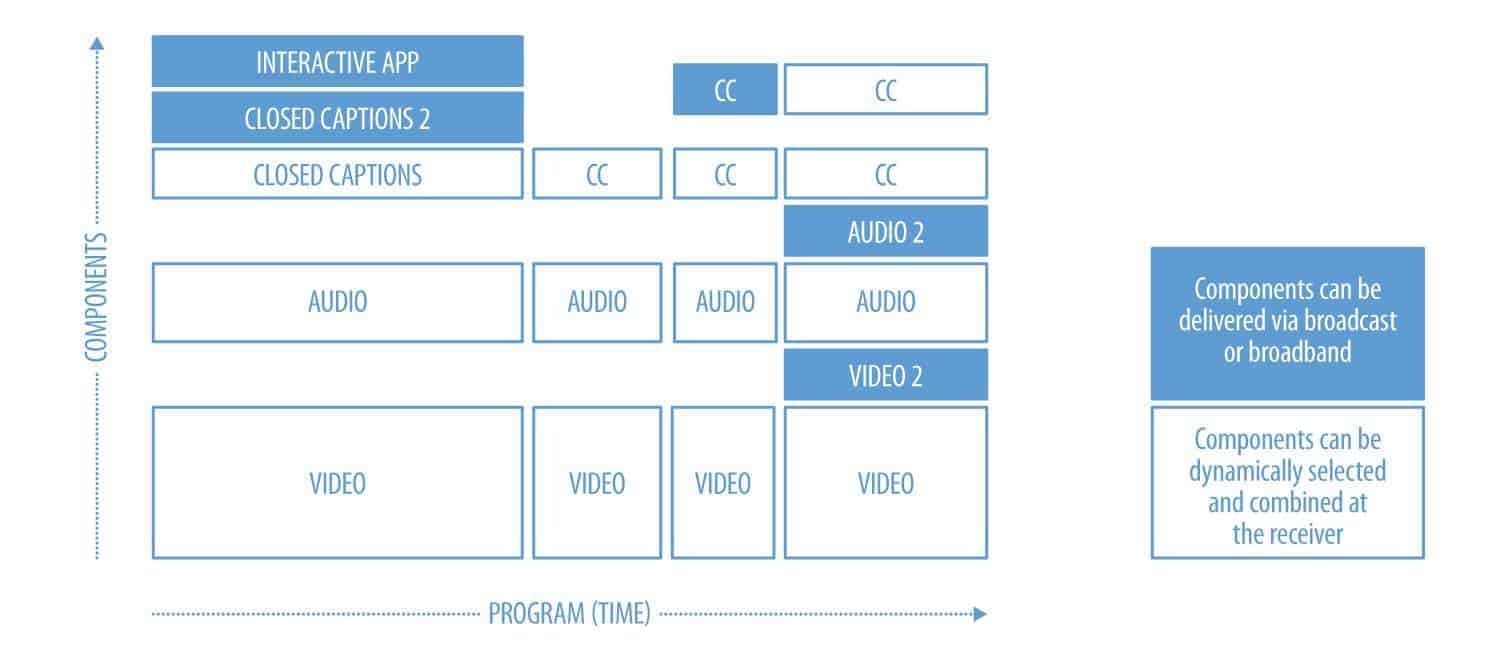“We will have perfect data all the time” says Sinclair exec about new TV broadcast technology that enables them to collect data on consumers through TV sets and mobile devices.
Overview
- Outdated local broadcast TV is being replaced by a new, broadband-enabled standard called ‘Next Gen TV’.
- ‘Next Gen TV’ will allow broadcasters to track and collect data on consumers through their TVs and other connected devices, much like Google and Facebook.
- Many of the patents underpinning ‘Next Gen’ technology are owned by Sinclair, a conservative-leaning media group.
- Sinclair is close to FCC approval on a merger deal with Tribune, giving them access to 72% of US households.
- Privacy advocates are concerned about comprehensive nationwide data collection and consumer targeting by one dominant media group.
Are you a journalist or researcher writing about this topic?
Contact us and we'll connect you with a broadband market expert on our team who can provide insights and data to support your work.
A new IP-based broadcast technology is being rolled out which will enable local television broadcasters to track consumers and serve targeted advertisements the same way Facebook, Google and YouTube already do.
The new technology, called “next Gen TV,” promises to revolutionize broadcast TV by modernizing over the air video delivery for the 21st century, and bringing data-driven advertising solutions to antenna TV broadcasts.
Next Gen TV is supported by the new standard ATSC 3.0, an update from the current antiquated ATSC 1.0 standard. After five years of development, ATSC 3.0 saw its first commercial deployments earlier this year, three months after the FCC gave the OK for broadcasters to begin updating their infrastructure to support it.
Sinclair Broadcast Group is a major backer of next gen TV. Sinclair has invested over $30 million in Next Gen technology, and holds a handful of patents that are baked into the ATSC 3.0 standard.
In fact, Sinclair executives have routinely stated that ATSC 3.0 — and the new advancements in advertising technology for linear TV — will lay the foundation of Sinclair’s future growth strategy, encompassing terrestrial broadcast, Internet-delivered video, subscription services and even video delivery to connected cars.
But the technology will also give Sinclair — the largest broadcaster in the US — unprecedented access to viewer data. As Sinclair executive chairman David Smith described in a recent interview:
“We’ll know where you are, who you are, and what you’re doing — just like you do now, just like everybody does now, the Internet does, or Google, or a Facebook. We will have perfect data all the time.”
How Next Gen TV and ATSC 3.0 Work

Fast Facts
- ATSC 3.0 is a hybrid IP-based delivery standard.
- In addition to on-demand content, ATSC 3.0 enables advanced captioning, mobile viewing, and personalized advertising.
ATSC 3.0 is a hybrid broadcast and IP-based delivery standard. The technology was designed to accommodate new viewing behaviors, such as watching TV shows on-demand or on mobile devices, and offering new video technologies like 4K resolution or HDR (high dynamic range). The ATSC 3.0 standard is considered the biggest technological update to antenna TV since the transition to high definition digital signals in 2009.
ATSC 3.0 enables broadcasters to take advantage of video codec HEVC (H.265), which will allow them to pack more information into a broadcast, including things like:
- Multiple audio or captioning tracks
- On-demand viewing of popular shows without the need for a DVR
- delivering 4K UHD and HDR versions of content to compatible TV sets
The broadcast signals can be received and decoded by any display device with a tuner, which means devices like tablets and smartphones could also receive the signals, if hardware makers decide to build these devices with tuners inside. That would give broadcasters the ability to deliver “Mobile TV” — TV programming delivered directly to mobile devices.
And because the technology supports two-way communication between the broadcast station and the end user, ATSC 3.0 will also enable broadcasters to collect data about consumers’ viewing habits, much like Netflix and Comcast do.

Broadcasters can then use that data for a variety of things, such as analyzing precisely how many people tuned in to a specific show or sports event. That data will also be used to help determine which ads should be served to you while you are watching your favorite TV show, just as Facebook uses its data to personalize your feeds with videos and advertisements.
How Next Gen TV Enables Data-Driven Advertising on Local Broadcast Television

Fast Facts
- Sinclair is developing an advertising platform that provides unit and impression-based buys on Next Gen TV broadcasts.
- “Precise targeting” and “geographical positioning” are stated goals of the platform.
The rise of data-driven advertising over the past decade has fundamentally changed the entire media industry. The Internet enables two-way communication between source of content — ie the content provider, like YouTube or Comcast — and the end user, giving content providers an opportunity to see precisely how viewers are engaging with programming.
Digital advertising has further evolved thanks to social media. Data collected by social media networks like Facebook, Twitter, and Instagram have enabled marketers to learn more about consumers in general, and more specifically about the types of consumers they should aim to reach with their marketing messages and advertisements. Couple that online behavior data with viewership data, and content providers can offer incredibly powerful data-driven advertising solutions, delivering specific ads to specific consumers.
While cable, IPTV and satellite TV providers and TV networks have already begun leveraging digital advertising technologies within their own businesses, over the air broadcasters relying on ATSC 1.0 have largely been left behind in terms of modernized video delivery, and consequently innovation in data-driven advertising.
Enter ATSC 3.0. The technology gives broadcasters a chance to engage with targeted advertising in ways that were impossible with ATSC 1.0. Once the technology is fully deployed, broadcasters will be able to generate troves of viewership data, which they can then couple with other data sets in order to build a more robust advertising solution and attract more marketers and brands as advertising clients.
And that’s exactly what Sinclair is attempting to do now. The company announced it is developing an ATSC 3.0 advertising management software platform, focusing on business process systems for traffic, ad sales, and data analytics that allow for unit-and impression-based buys, all enabled by ATSC 3.0.
The advertising platform will ensure that Sinclair can “maximize the monetization opportunities that an IP delivery model offers by utilizing business systems that provide precise targeting and geographical positioning across all distribution and consumption models,” according to Sinclair CTO Del Parks.
ATSC 3.0 and Next Gen TV Deployment Timeline

Fast Facts
- Phoenix, Arizona is the first test market for ATSC 3.0 as of April 2018.
- Sinclair is encouraging smartphone manufacturers to put ATSC 3.0 tuners into the new models of their phones by offering ATSC 3.0 chips to them free of charge.
This week, the country’s first ATSC 3.0 signals were switched on in Phoenix, Arizona, where broadcasters agreed to make Phoenix the first test market for ATSC 3.0.
Sinclair has also announced a tower agreement with Univision, Nexstar and American Tower Corporation for deploying ATSC 3.0 in the Dallas, Texas market — which will serve as a “sandbox” for testing out the technology in a real-world deployment ahead of a national launch of next gen TV.
But it will take years before the new broadcast standard is available in most households in the US. First, broadcasters have to upgrade their station infrastructure, which takes time and money. The FCC has mandated that ATSC 1.0 signals continue to be transmitted for at least the next five years, and because the FCC has not allocated any new channel space for ATSC 3.0, broadcasters will need to be able to support both. In Phoenix, local station groups have agreed to share transmission infrastructure, but that solution will not work for every market. More likely, Sinclair and the other broadcasters will deploy ATSC 3.0 in their largest and most lucrative markets first. Sinclair expects to have only 24 stations across the country broadcasting in ATSC 3.0 by the end of the year.

To help speed things along, Sinclair signed up broadcasters Nexstar Media Group and Univision to create an ATSC 3.0 consortium, aimed at promoting things like spectrum aggregation, monetization and innovation using the new technology.
Consumers will also have to buy new hardware in order to receive the new signals, a fact that will introduce more friction in the technology’s deployment. At CES this year, LG was the only TV maker showing an ATSC 3.0-compatible TV set. The other TV manufacturers will likely wait until the broadcast technology has more penetration across the US before committing to it at scale. Sinclair is also hoping that phonemakers will put ATSC 3.0 tuners into the new models of their phones. Sinclair has tried to entice phone makers to support next gen TV by offering ATSC 3.0 chips to them for free.
Data, Privacy, and the Sinclair Media Group Vision for ‘Next Gen TV’

Fast Facts
- When their Tribune merger is approved, Sinclair will operate 233 stations in 108 markets, including 39 of the top 50 markets, covering some 72% of US households.
- Sinclair executives have argued that such consolidation has become necessary for broadcasters to be able to compete effectively against cable TV and streaming video providers.
- Sinclair has faced public criticism over the airing of “must run” right-leaning political segments that refer to other media outlets as “fake news.”
Sinclair is in a unique position to benefit from ATSC 3.0 in ways that other broadcasters won’t. The company has successfully doubled its footprint through a number of strategic acquisitions over the past two decades, including the recent acquisition of Bonten Media and the proposed acquisition of Tribune Media last year. With those two acquisitions in the fold, Sinclair will operate 233 stations in 108 markets, including 39 of the top 50 markets, covering some 72% of US households.
This is the first time the country has seen such consolidation of broadcasting power and influence into the hands of one station group. By comparison, Nexstar Media reaches 39% of US households, CBS reaches 38%, and Fox reaches 37%, according to Nielsen data. In other words, Sinclair will have nearly twice the reach of any of the other major broadcasters in the country.
The ramifications of that consolidation are still being drawn out. Sinclair’s proposed acquisition of Tribune Media drew significant criticism from politicians and consumer advocacy groups, who argued that such consolidation was not in the public interest. The acquisition is still being reviewed by the Justice Department for antitrust violations. Sinclair is now facing criticism for its “must-run” editorial segments, which the company has been accused of using to push out a political agenda, masqueraded as local news, across huge swaths of the country.
Sinclair executives have argued that such consolidation has become necessary for broadcasters to be able to compete effectively against cable TV and streaming video providers. The company’s extra-large coverage footprint will enable Sinclair to pool audiences in order to sell ad inventory on an impression-basis with enough scale to compete favorably with all the other ad-supported video platforms that are currently vying for advertising dollars — including the digital kings Google, Facebook, Amazon and Twitter.
Is Surveillance via Local Broadcast TV Inevitable?

Fast Facts
- The FCC explicitly passed the responsibility of policing data privacy issues to the FTC when they approved ATSC 3.0 earlier this year.
- The ATSC standard itself doesn’t cover what type of data can be collected, how that data can be used, nor how broadcasters should protect that data.
- The FTC has not yet drafted any guidelines or regulations about data collection via ATSC 3.0 broadcasts.
ATSC 3.0 opens the door for data collection on yet another platform, which has become a growing concern for consumers as more and more of our daily lives occurs online. To date, the US government hasn’t had much of a track record of protecting consumers’ online data. The last attempt to enact an over-arching data protection law, dubbed the Consumer Privacy Bill of Rights, died in Congress after a protracted national debate. Instead, data collecting entities have enjoyed self-regulation of data policies, to varying degrees of success.
And while data privacy has been a hot button issue for the past five years, recent scandals involving social networks, advertising and personal data have placed data mongering under increased scrutiny. Facebook is currently weathering particularly harsh backlash over revelations that one of its data customers, Cambridge Analytica, was given improper access to Facebook users’ personal data to use for its own purposes. That scandal has now spread to more of Facebook’s data partners.
It’s unclear if the recent swell of privacy concerns will lead to any meaningful data protection policy updates, or how those policies may impact broadcasters’ advertising ambitions. When the FCC approved ATSC 3.0 last year, it specifically noted that any future data collection initiatives used by broadcasters through ATSC 3.0 would be governed by the Federal Trade Commission’s privacy guidelines. In other words, the FCC punted the privacy football to the FTC. (See our post on the FCC vs the FTC for why this distinction matters.)
The ATSC standard itself doesn’t cover what type of data can be collected, how that data can be used, nor how broadcasters should protect that data; and the FTC hasn’t yet formally outlined a data policy for ATSC 3.0. As it stands now, broadcasters are only legally allowed to use the new technology for one-way transmissions from broadcaster to viewer. Those details will need to be worked out before the technology sees widespread deployment across the country over the next five years.

